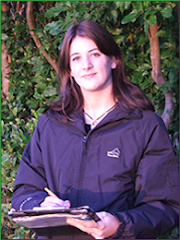
Photo by Hans Hillewaert licensed under Creative Commons Attribution-Share Alike 2.5 Generic license.
In the pond, a large, black beetle broke the surface, whilst smaller golden beetles busied themselves in the mud. The pond skaters were wrapped up in their own little world, mating, bickering over food and lazing around on the surface. Stars started to appear in the darkening sky. The birds became silent. There was a rustling in the hedge. Something large was rooting around and I waited with baited breath for it to appear, suspecting a badger. But then, a dog barked and the mysterious creature went quiet. A bat flew out of nowhere and swooped low over the pond. I whipped out my latest piece of kit – a bat detector - and tried to work out what species I was looking at. It darted around the pond and skimmed the lawn. On the detector, its ultrasonic calls were made audible, buzzes revealing when it was feeding. It was loudest at about 45KHz and was perhaps a pipistrelle, although I couldn’t be sure. The air was chilly now and I stood up, to search for any other animals in my garden. I scanned the the pond with a torch for newts or frogs and looked in the hedgerow for hedgehogs, but there were none to be found. I may not have been able to tick off many of the species on the Wildest Hide and Seek list, but it was a fantastic excuse to simply sit and watch the world go by for a while.
Now all I have to do is upload my results!
Now you do it
The Wildfowl & Wetlands Trust (WWT) ‘Wildest Hide & Seek’ study runs until Monday 31st May, so there are still a few days left to take part. The survey is looking at the effects wetlands may have on the range of wildlife found nearby and marks the International Year of Biodiversity.
In true ‘Hide & Seek’ fashion, participants spend some time hiding quietly in their garden or nearest open space, followed by a few minutes of seeking and recording the wildlife they see.
As a big ‘Thank You’, those who take part will also receive a 2 for 1 voucher for entry to their local WWT centre.
Find out more about how to take part, and download a survey guide (or pick up a copy at your local Wetland centre)
In support of the ‘Wildest Hide & Seek’ survey wildlife enthusiasts have also been submitting their own YouTube videos to the WWT ‘Be Your Favourite TV Presenter’ competition.

